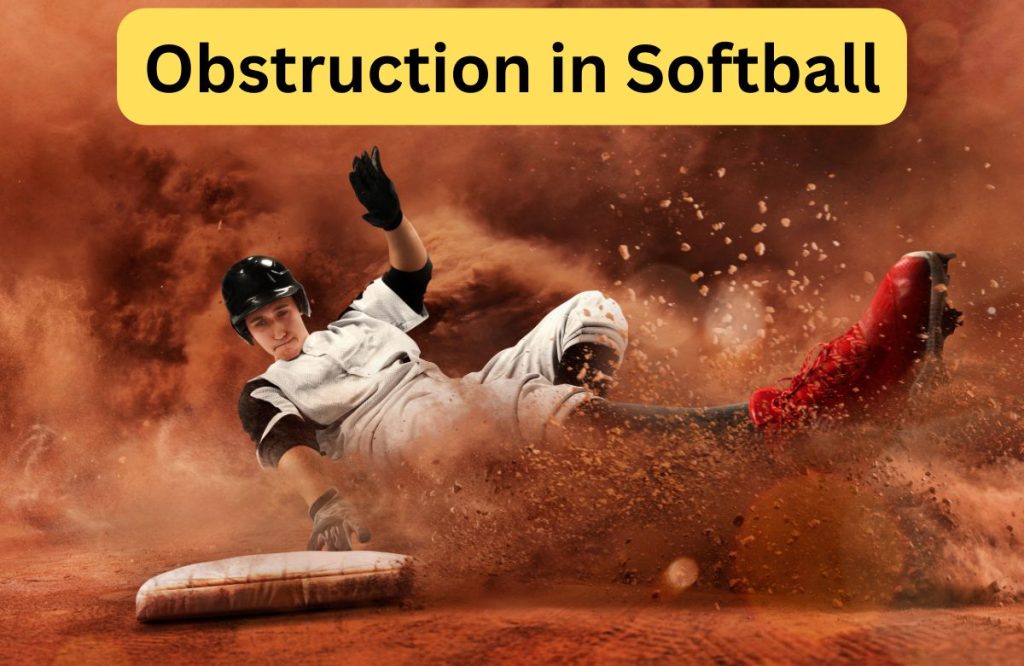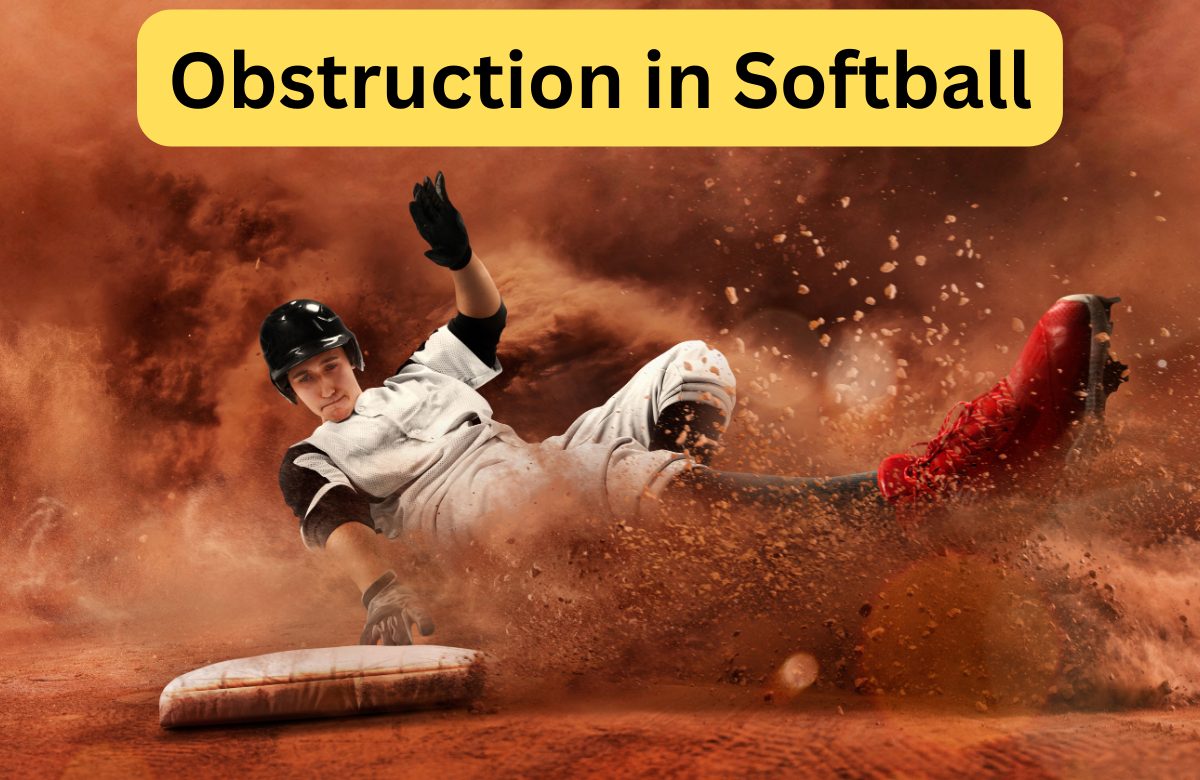
Obstruction rule in softball refers to any physical conduct or movement that leads to stopping the attacking player from sliding toward the base. This also refers to an act by a defensive player that blocks or hinders the progression of an offensive player who attempts to advance toward the base. There are two different types of obstructions: outfield obstruction and runner obstruction.
A Fielder’s obstruction occurs when a defensive player gets into the path of the other player by blocking the way toward the base or preventing the runner from progressing. On the other hand, Runner obstruction occurs when a defensive player is obstructed by an offensive player. This can happen due to intentional or unintentional interference with the fielder who is up for catching the ball or exhibiting a throw.
For now, you might not have the idea of these players but on reading this your knowledge of the game will be different. In this article, we will be discussing the details of softball obstruction rules, types of obstruction, and how they impact the game.
without further delay let’s get to the point.
Do you know about offensive obstruction?
Generally, offensive obstruction occurs in softball when a player blocks the progression of the defensive player who is heading to make a score. This happens in multiple ways that include making intentional contact, hindering the path, or interrupting the defensive players while catching the ball.
There is a detailed review of offensive impediments. Let’s dive into it.
- Runner’s Interruption: This happens when a fielder’s path is interrupted by the runner intentionally and the intent is to disrupt the fielder’s effort of reaching the base.
- Hitter interference: When a batter advertently hinders a catcher’s throw to a base or interferes with an attempt to catch a ball, this can occur.
- Coach interference: This can occur as a result of a coach’s interference with a fielder’s effort to catch a ball, either intentionally or inadvertently, or tossing equipment into the field. This sort is not very common.
What could be the ramifications of offensive obstruction?
Normally the degree of obstruction and the umpire’s final judgment decides the ramification. The penalty in most cases is entailing the play as dead and the issuance of a fine to the defending team. Furthermore, runners on base may be compelled to return to their starting point. The game can be replayed starting from the moment of obstruction. It is on the umpire to issue the warning letter to the player or the player could be expelled from the game in extensive circumstances.
What is the defensive obstacle?
Defensive obstacles occur as a result of defensive players’ interference with the baserunner who is heading towards the next base. There are certain impediments to such types of obstructions in softball. Let’s have a look at them.
- Base obstruction: This results when a defensive player stands in front of the base making it difficult for the base runner to touch it.
- Impeding the runner’s progress: This can happen when a baserunner is prevented from moving ahead by the defensive player who stands in the baseline.
- Making contact with the runner: When a defensive player makes contact with the baserunner in a way that makes it difficult for them to move freely.
The Effects of Defensive Obstruction
The effects are clearly determined by the intensity of the offense. In the case of the base runner’s obstruction by the defensive player, it’s on the umpire to take the decision, he could award the base to the baserunner they were trying to reach. He could either dismiss the defensive player if the interference was obvious and intentional.
Here are a few examples of softball defensive obstruction:
- When a baserunner heads towards reaching the second base is obstructed by the catcher in the front of the base which keeps them from reaching their destination.
- This happens on the baserunner’s attempt to advance to third base. The third baseman steps into the runner’s path preventing them from reaching the base.
- The fielding pitcher’s attempt to make contact with the runner prevents them from touching the base on a ground ball.
Detailed Review of the Softball Obstruction Rule
Softball is a known game that is cherished by a large group of people. In this game, besides certain other rules, some obstruction rules are also involved. These rules are crucial for every player, and coach, and also for the common man who takes an interest in this sport. As it is earlier discussed that obstruction in softball happens when a defensive player interferes with a runner’s ability to proceed or return to a base. This can happen in multiple ways when the runner’s route is obstructed by the fielder who stands in the baseline. Also it can happen when the catcher instead of focusing on grabbing the ball blocks the runner from scoring.
These obstruction rules intend to maintain fair and legit play and also ensure players’ safety. When the obstruction occurs the umpire awards the obstructed runner with a base that he would have reached if he were not obstructed, also sometimes the ball is declared a dead ball. Moreover, not all contacts are regarded as obstruction, let’s take an example of a defensive player who makes contact with the runner who is driving a play on the ball, this contact will not be taken as obstruction until and unless it is done unnecessarily or intensional.
Critical Understanding of the Obstruction Rules
Knowing and understanding the obstruction rules would be helpful as it will assist the players how to avoid the errors that could cost them their game. Coaches also must have a good knowledge of these rules because only then they could comprehend the game properly and can assist the players to play carefully keeping them in mind because this can give extra scores to the other player, for instance, if a fielder comes in the route of the runner, the runner might get extra base because of this intensional hindrance. Also, they can utilize their knowledge when not satisfied with the decision or if they think it is made unfairly.
When it comes to spectators who have a keen interest in the game will enjoy it fully if they understand what’s going on. They will be capable of tracking the performance more attentively and understand why certain decisions were taken. It will make the game intriguing as this perception will create chills in the hearts of the fans regarding the game-changing obstruction rules.
when an obstruction occurs?
There is no specific time of obstruction in the play, it can occur at any time throughout the game. Well, we can say that it is more obvious when a runner attempts to proceed toward the base. In case of a runner who tries to head towards the second base is blocked by the catcher this conduct will be termed as obstruction.
The Effects of Obstruction
There are multiple effects of obstruction on the game based on its type and intensity. If a player is being hindered unfairly while heading toward the base the umpire will regard the play as dead and the runner will be awarded the base he was intending to reach. He will be given the runs if he is being obstructed at home plate and prevented from scoring the run. Moreover, the player who repeatedly does it will be removed from the game. To avoid these outcomes it is necessary to have a clear knowledge of the game and its rules. It will help them in avoiding the unnecessary obstructions and save the game.
Final Thoughts:
It is crucial for all players, coaches, and spectators who are fond of the game to have explicit knowledge of the obstruction rules. This will enable them to avoid unnecessary fouls and save the game. Obstruction can lead the game in a different direction. The umpire can call the play dead or he could award the obstructed player with the base he was intending to reach or in extensive circumstances, he could expel the player who committed obvious and intentional obstruction. Overall a better understanding can help in avoiding these outcomes.

